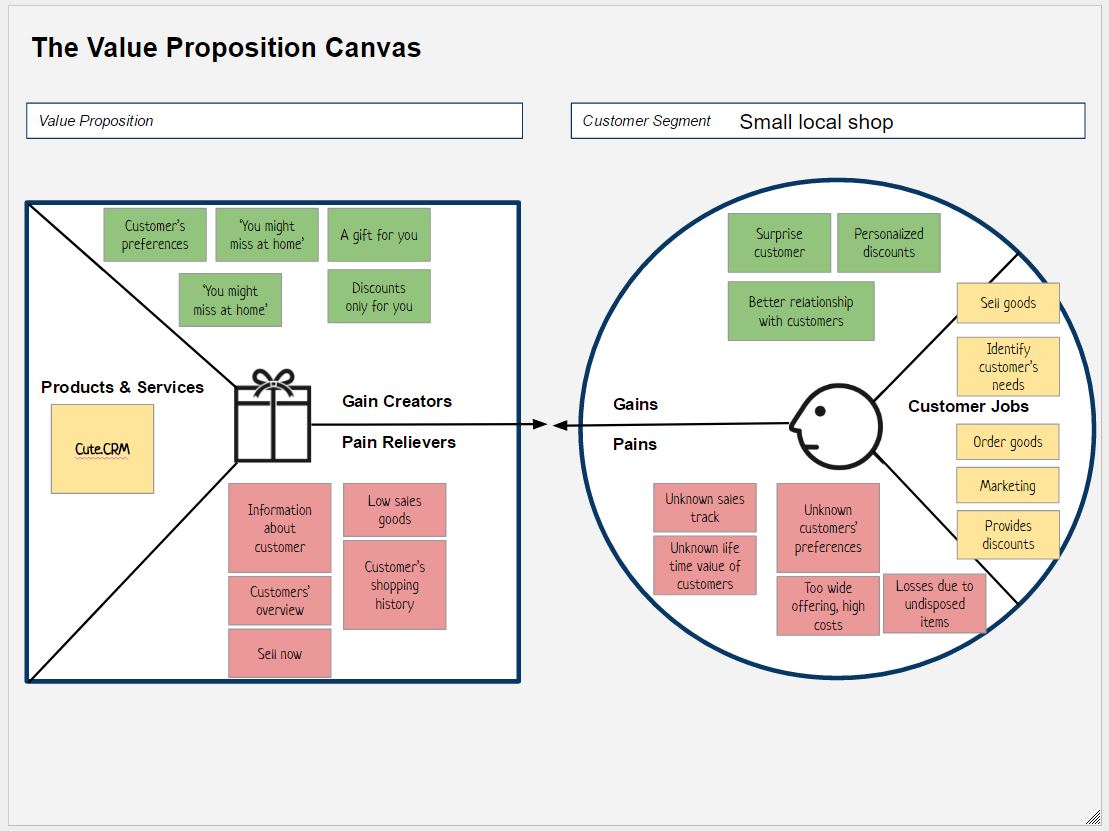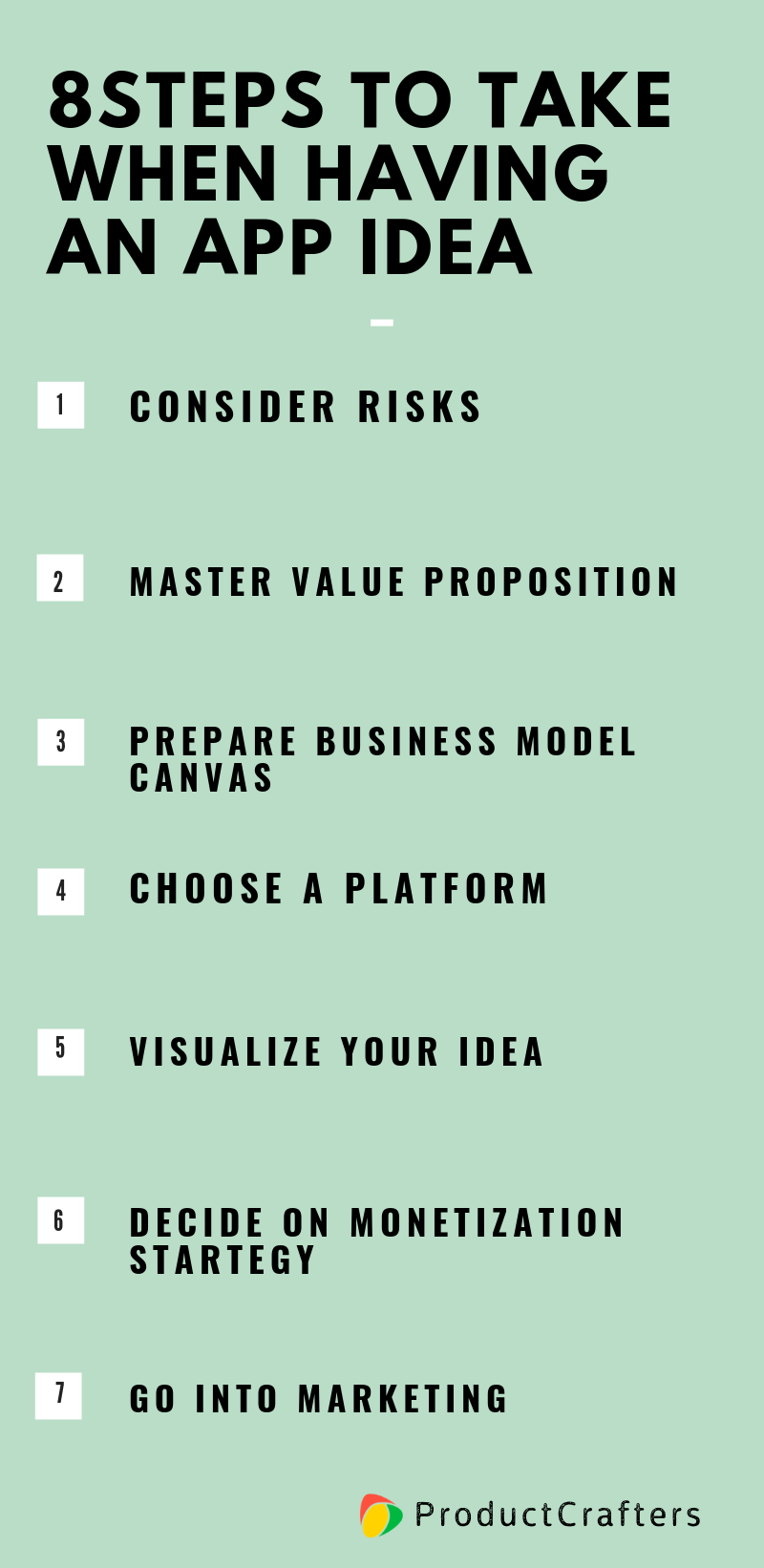I have an idea for an app! Wait… what’s next?
Some time usually passes between the first time you came out with an incredible app idea and the final decision to build it. And this time is full of magical dreams, amazing wishes, and tremendous plans. But as soon as you decide to implement it, reality kicks back in. It’s hard to figure out what to do next. Moreover, now you have to take care of countless boring duties connected with its implementation. What is even worse, hesitation shows up and makes you feel unsure about the app’s success. But the longer you wait the fewer chances you have. So if you don’t know what to start from and who to ask, this article is for you.
Consider Risks
Building the app is the beginning of your business. No wonder it’s going to take a lot of your time and money. And you are supposed to be ready for it. But how about dedication? How much are you ready to dedicated to building the app? Are you fully committed? This is what you have to consider first of all. Tech startup can eventually bring you a high reward. At the same time, high risks are an integral part of tech startups. Without a full dedication and understanding of the risks involved, you could lose a lot of money and time. So, you have to clearly understand how much you can dedicate.
Master Value Proposition
Nowadays it can be hard to become discovered, as there are so many tech startups on the stage. The only way to achieve success is to show customers why they should use your app instead of going to your competitors. Your value proposition has to be your unique identifier. It’s not just a product you deliver to users, it’s the part of your business that solves a problem your competitors either can’t or do it worse.
To come up with a decent value proposition, start with creating a value proposition canvas. This is a tool that allows you to understand what your end users want and how to quickly satisfy these wants.
To prepare a value proposition canvas you have to answer such main questions:
- What are the pains of your end-users? (Pains)
- What do they want to gain? (Gains)
- How your app can solve those pains? (Pain Relievers)
There are two main risks you can face at the inception stage of your idea. The first one is losing the focus and therefore the understanding how to move forward. Another risk is to develop the app in the wrong direction with a low-demand product as a result. Value Proposition Canvas helps to stay focused and keep in line with the product. With this tool, you can deeply understand users, their needs, pains, and solution to these pains.
This knowledge can give you an idea of what features should the product possess. Thus all your efforts will be directed to a certain goal.
Prepare Business Model Canvas
The fundamental part of building the business is the business model. It describes how an organization creates, delivers, and captures value. There is a tool that helps to create it with fewer efforts – Business Model Canvas. It helps to focus on building crucial elements of the business model.
You don’t have to worry about building a detailed business plan until you find a product-market fit. This tool will help you to replace pages of analytics and formulas. You just need to figure out the basics and how they work together.

To use the Business Model Canvas you need to fulfill 9 forms. Write down in each box what exactly will work best for you and for your business.
Here are the benefits of preparing Business Model Canvas:
Fast and Agile
Time is the most important resource we possess and can dedicate to our business. And Business Model Canvas helps to save a huge amount of it. It’s easy to understand what should be filled in every element of this tool. No, you can’t do it in 15 minutes. But dedicating a few hours will give you a clear picture of what you need to generate revenue. You can also adjust and modify it with the flow of time.
Focusing on Value
Value Proposition is at the heart of the Business Model Canvas. It makes you think about what you deliver to users and which pains you solve. To become successful, it’s necessary to start from users. Weak startups tend to start with the product and hope there is a market demand for it. Users are at the end of the development process.
Identifying risks
Using canvas you can identify risks at an early stage, as they provide you with the input data. You can measure all obstacles and prepare an effective strategy for future growth. Though it doesn’t mean you will not fail, you will be able to consider all bottlenecks and pivot if necessary.
Choose a Platform for Your Idea
Today the most popular and widespread platforms are Android and iOS. When starting to build the app you have to examine your target audience and decide which platform they prefer. There are different types of users, some of them tend to use iOS devices, others Android. So the right platform choice can significantly increase your chances to get more customers, especially at an early stage. Moreover, there is a great difference between their app stores and launching there. The Apple App Store and Google Play Store are dominating and they are two of the most important marketplaces in the world.
Let’s take a look at some statistics.
In the first quarter of 2019, 2.6 million app downloads were conducted at Google Play. At the same time, the Apple App Store had only 2.2 million downloads.
If to look back (2017-2018), a discrepancy between the number of downloads on different platforms was even more noticeable.
However, the situation is different if we take a look at the annual revenue stats.
Up to the Sensor Tower reports, iOS App Store 2018 revenue came to $46.6 billion, while Google Play revenue stood at $24.8 billion by this measure. Yet, these revenue statistics also show that Google Play revenue increased by a greater percentage between 2017 and 2018: 27.3% to the App Store’s 20.4%
If this data isn’t sufficient enough for you to make a decision, check other stats. The criteria can depend on the type of your app (gaming app, social, marketplace, fintech, etc) and characteristics of targeted users (age, social status, profession, preferences).
Visualize Your Idea
Depicting your app idea on the piece of paper sounds like an easy task, doesn’t it? Still, this is one of the most important steps on the way to defining business needs. It will also help to explain to future developers what to do and why to do it. You can dive into details as deep as you want. But detailed description will make time and money estimation more accurate.
Start with preparing wireframes. This is a simple sketch, that can be done either in a notebook or with the help of an online tool. You can try Wireframe.cc or Wirify. By depicting the screens of the app, you’ll think through the user flow and reveal all bottlenecks of your project.
Wireframes help to do all the above without distracting details like colors. The user flow should be clear without adding colors or shapes.
Moreover, wireframes work as a common language between you, users, designers, and programmers. They are detailed enough to inform everyone of what to do. At the same time, they are simple enough not to make you tangled by too many details.
The next step is to prepare a mockup. This is a visual representation of your app. This is the stage when you implement your visual decisions and give your product visual traits.
And the final step before passing the work to programmers is to create a prototype. This is the stage when you make your mockup interactive and can even present it to some users. (It’s never too early to receive feedback). A prototype is the most functional draft of your product. Having defined all the features and navigation elements, you will be able to fully immerse developers into your project.
Decide on Monetization Strategy
There are two different types of apps on the market: free and paid. For example, Instagram. It is a free app, that is on top of both the Android and iOS stores. Even though users don’t have to pay for downloading the app, it brings money to its founders. Now raises the question: how to do the same? Should you launch a paid app or a free one?
Let’s take a look at the most popular monetization strategies.
In-app purchases
This is a popular method of monetization on both iOS and Android platforms. At this strategy, the app is free but provides extra features for purchase. This is the most stable way of getting revenue. Especially popular this strategy is among game apps, as users can buy there additional skills, artifacts, extra lives.
In-app Advertising
As the app remains free, it becomes easier to scale users when there’s no cost required to download. With ads, it’s also possible to adjust targeting options so that you can reach the most desirable users. Also, there are different types of advertisements. It can be interstitial ads (fills up the whole application window), banners or videos.
Pro-version
You can develop two versions of your app. One with the basic set of features, while the other with additional ones or with the possibility to turn off ads. Thus the app with the basic features should be free, while pro-version should be paid.
And you can always go with the paid applications.
Mention that the Apple Store tends to have higher prices. So, if you are going to sell your app, then a better choice will be the iOS platform. If you want to focus on an advertisement, Android apps will work better.
However, in this case, your product should be really unique and valuable to be able to compete with all the free apps on the market. Also, some applications offer a limited free-trial period. Users receive a chance to try the app and if they want to continue using it after the free-trial period, they should pay.
Arm Yourself with Marketing
Marketing should become an integral part of your life from the very beginning of idea implementation. If you want to get users for your app, you need to promote your idea. Start a marketing campaign and never stop doing it.
There are many options of what you can do, and here are a few of them:
Build a website
This is a unique way to connect with your potential users. By building a simple website you’ll get an opportunity to show your app advantages and competitive edge. Moreover, the best way to start content marketing is by creating a blog on your website with useful content for targeted users.
Use Social Media
Make official pages of your app on various social media platforms: Facebook, Linkedin, Twitter, Instagram, or even Youtube. Join different communities that suit your product. Maintain conversations with community members and keep in touch with your subscribers. You can share with them the latest news about your app, ask for feedback on it, or convey a survey about the desired features. Moreover, you can use these channels to organize live events with targeted users.
Starting the work on your idea is always the hardest part. Even if you have the best idea ever, it means nothing if it isn’t implemented. So decide whether you are committed enough and have the guts to bring it to success. If yes, be brave and get down to work.
Read more:
– How to Start a Software Company
– Tips on How to Hire a Reliable Development Company for Your Startup
– Minimum Viable Product: Definition, Benefits and Example












